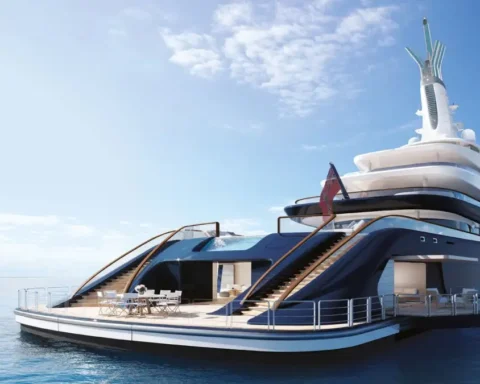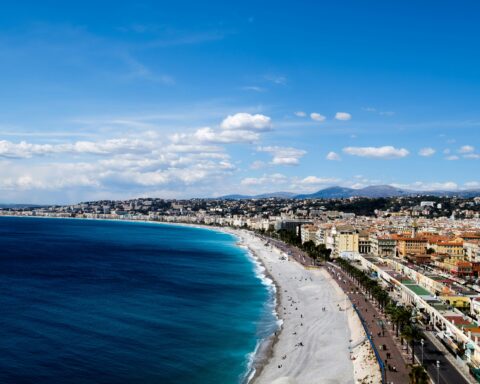A “cathedral of commerce” born in Paris under the Second Empire, the department store was both the symbol of a triumphant consumer society and a player in the evolution of the female condition. Despite the stock market crash of 1929, competition from hypermarkets and e-commerce, the model has managed to reinvent itself, remaining, from the City of Light to Doha, from London to Tokyo and from Milan to New York, a shopping destination in its own right.
They include Le Printemps, Galeries Lafayette, Harrods, La Rinascente, El Corte Inglés, De Bijenkorf, KaDeWe, Takashimaya, Macy’s and Neiman Marcus. Although the names, cultural influences and brands distributed differ, all these department stores owe a great deal to a certain Aristide Boucicaut, founder in 1852 of the very first of these temples to consumerism: Le Bon Marché.
Two exhibitions in Paris look back at the origins of these gigantic stores, from their architecture to their range of products and services, and their daily flow of visitors.
The first takes place at the Musée des Arts Décoratifs (MAD) from April 10 to October 13, 2024. The second will take place at the Cité de l’architecture from November 6 to April 6, 2025.
Au bonheur des dames
Our story begins in the City of Light, on the corner of rue de Sèvres and rue du Bac. It was here thatAristide Boucicaut, the son of a hatmaker from Normandy, came to Paris to work as a calicot (novelty salesman), and came up with an idea that would forever change the face of the shopping experience in the mid-19th century.
He was the first to reproduce on a larger scale the novelty stores he had worked in. The textile items (shawls, hats, gloves, stockings, ribbons, lace, etc.) that gave their name to this type of business were to make up theinitial offering of his “Au Bon Marché” establishment. This extensive range was later extended to include carpets, travel goods, perfumes, stationery, toys and ready-to-wear clothing.
Enlarged and inaugurated in 1872, this XXL store lends itself to strolling, with its wide aisles and open spaces. It already featured the elements that would become a benchmark throughout France and the world: multiple themed departments and floors, an exposed riveted metal structure, a central space served by a monumental staircase (later replaced by escalators), domed roofs and immense display windows.
With his wife Marguerite, Aristide Boucicaut laid the foundations fora new form of commerce based on accelerated stock rotation, and hence capital. They came up with the idea of reducing their profit margins (15-20% compared with 30-40% in traditional retailing)to offer a burgeoning bourgeoisie quality or semi-luxury products, which until then had been the preserve of the very wealthy. To achieve this, they negotiate special prices directly with their regional suppliers.
In addition to more affordable prices than elsewhere, they offered free, no-obligation entry anda fixed price, far removed from the haggling – often endless – that was then the norm.
To stimulate sales and create temptation among a clientele that at the time consisted of 80% women, he relied on display, a new discipline that would later give rise to Visual Merchandising in the United States. From then on, the product was no longer concealed, but presented in majesty, with the building’s architectural features serving as displays.
A new sensory experience is offered to customers, who can freely touch and try them on, while sales staff can provide simple advice.
Finally, if a swarm of customers flocked to what appeared to be a beehive, it was to take part in the many promotional events set up by the Boucicaut couple. In particular, the couple initiated a “white month” dedicated to household linen (in January), to stimulate sales in a period after the end-of-year festivities, reputed to be sluggish.
Finally, the image of the department store reached into the comfort of the home with the development of mail-order sales and catalog publishing.
An object of temptation with its continuous flow of new products, it is this generic department store, a new omniscient public space, that writer Émile Zola recounts in what remains one of his seminal works, “Au Bonheur des dames”, published in 1883.
50 years of golden age
Boucicaut’s version of the department store was soon emulated in Paris.
1856 saw the founding of “Grands Magasins Dufayel”, then “Palais de la Nouveauté”, on rue de Clignancourt in the Montmartre district. The establishment changed name with its new owner and former employee, Georges Dufayel. A pioneer in consumer credit, Grands Magasins Dufayel foreshadowed the wave of democratization that would characterize the model during the Trente Glorieuses.
In 1865, Jules Jaluzot, who had just acquired three floors of a Haussmann building, christened his store “Le Printemps“. A visionary like the founder of Le Bon Marché, he banked on the development of the railroads and the promenade with its adjoining covered passages to transform a location far from the heart of Paris into a real asset.
Like its model, Le Printemps innovated by creating the sales period, which enabled products that had gone out of fashion to be sold at knock-down prices. In 1874, the department store was the first to install an iron bridge linking the historic building to its new adjacent space on rue de Provence, as well as two elevators.
La Samaritaine followed in 1870.
Following in their footsteps, two cousins from Alsace, Théophile Bader and Alphonse Khan, opened “Les Galeries“, a modest 70 m² store at 1 rue Lafayette in 1893. Because of its location and layout, the store was renamed “Aux Galeries”. Such was its success that not only the entire rue Lafayette building, but also those at 15 rue Lafayette and 38, 40 and 42 boulevard Haussmann were purchased and annexed to the original building,
Galeries Lafayette was the first to install non-retail spaces such as a tearoom, reading room and smoking room within its walls.
In 1906, the Grand Bazar on rue de Rennes was inaugurated.
At its peak in 1912, the “Grands Magasins Dufayel” was the world’s largest department store, with 15,000 employees working in a hectare of building in the heart of Paris. Caught up in the turbulence of the world, the department store could not withstand the stock market crash of 1929 and closed its doors for good.
Conquering the world
Originally a purely Parisian phenomenon, the Boucicaut department store inspired other nations to create their own national flagships.
In London, businessman Charles Henry Harrod opened his business – a simple grocery store – in 1843, before moving it fifteen years later to the Knightsbridge district with its famous motto “Omnia, Ubique, Omnibus”. Attached to its roots, the new building features its emblematic food hall on the first floor. A universe that will inspire the Grande Epicerie du Bon Marché and Galeries Lafayette Gourmet.
Harrods was the first store in Paris to install escalators, in 1898. Completely destroyed by fire, it was rebuilt with its emblematic 1900 terracotta façade.
In 1909, Harry Gordon Selfridge, a Wisconsin-born American who had cut his teeth at the Marshall Field department store in the U.S., bought a six-storey building for £400,000, which would take his name to become Selfridges, London’s second-largest temple to consumerism behind Harrods.
Promoting “a new shopping experience“, the building features a library, restaurant, toilets, lounges and reception rooms. Above all, Selfridges is the first to place make-up and perfume items on the first floor.
Other European countries gave birth to their own department stores, such as Italy’s La Rinascente in Milan (1865), the Netherlands’ De Bijenkorf (1870), Switzerland’s Globus in Zurich and Germany’s KaDeWe (1907 ), followed by Spain’s El Corte Inglés (1934).
In Kyoto, Japan, Linda Shinschichi opened her Takashimaya store in 1829. But it was thanks to the successful alliance between this kimono merchant and the American brokerage firm Smith Baker & Co. that it became a fully-fledged department store in 1932. With a presence in the Japanese archipelago, the brand was also present in New York, Taipei, Paris and Singapore.
International expansion accelerated in the 1980s. The period was marked byincreasing competition from hypermarkets and supermarkets, as well as by the financialization of luxury goods. Economic polycrisis and inflation in retail rents prompted retailers to rethink their business models and gradually target foreign customers with high purchasing power. As a sign of this change of gear, the traditional Christmas window displays (born in 1909 at Le Bon Marché) switched from toys to luxury brands at the turn of the 2010s. In 2012, Printemps featured Dior, Galeries Lafayette, Vuitton and BHV, Alexis Mabille.
Thinking of the department store first and foremost as “a sales machine“, marketing strategy and space rationalization become key, while most brands begin to open up internationally, particularly to Asian (led by Japan) and Middle Eastern markets.
In 1984, LVMH bought Le Bon Marché; four years later, Egyptian businessman Mohammed Al Fayed took over the London gem Harrods. In 1991, PPR (now Kering) acquired the Printemps group, before selling it to a businessman who owned La Rinascente. In 2013, Le Printemps fell into the hands of the Qatari fund DISA. Despite the climate of mergers and acquisitions, Galeries Lafayette is one of the few brands to retain its family-owned status.
In the early 2000s, after Dubai and Casablanca, Galeries Lafayette set out to conquer the Qatari and Chinese markets. In the wake of Beijing and Shanghai, the French group opened a unit in Shenzhen in summer 2023 and in Macau in February 2024.
Outdistanced by its rival in the hearts of foreign tourists, Printemps is resuming its internationalization strategy after being forced to close its Japanese establishment in 2017. The brand has opened a store in Doha’s L’Oasis shopping complex at the end of 2022, before setting course for New York in the Wall Street district in spring 2024.
Finally, while the resurrection of the Grands Magasins Dufayel is not on the agenda, its historic façade – entirely preserved – is about to begin a third life with Vinci. Scheduled for completion in summer 2024, the WOW project promises 11,336 m² of office and service space and, above all, 1,200 m² of terraces on every floor.
Read also > VANDERBILT, ROCKEFELLER, CARNEGIE AND JP MORGAN: THE FOUNDING FATHERS OF AMERICAN CAPITALISM
Featured Photo: Les Grands Magasins Dufayel poster 1895-1900 © Musée des Arts Décoratifs















